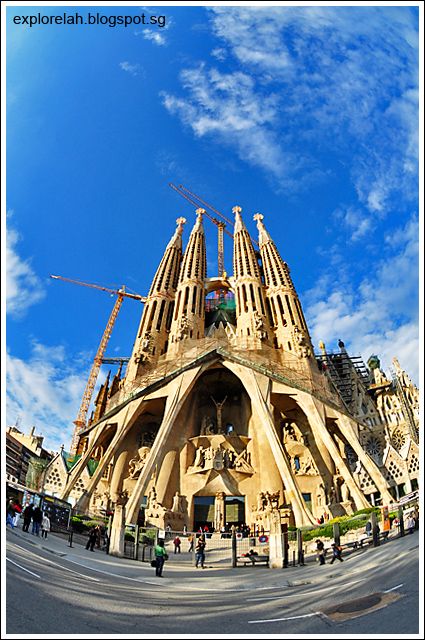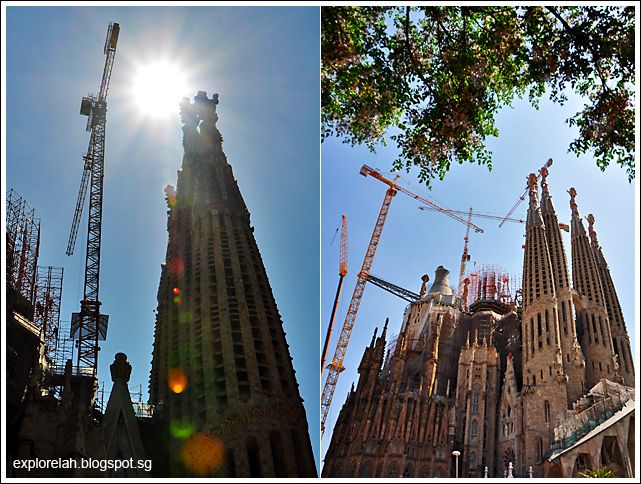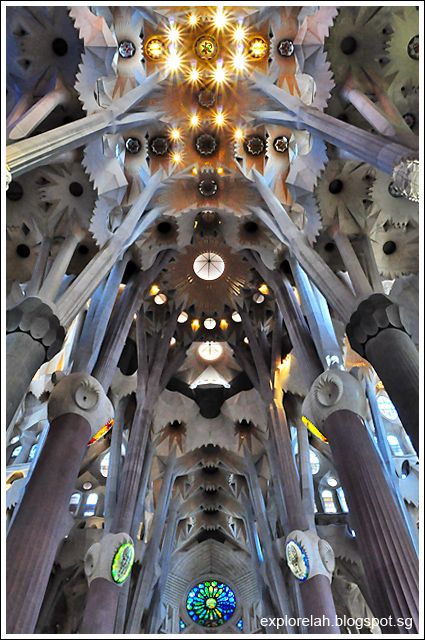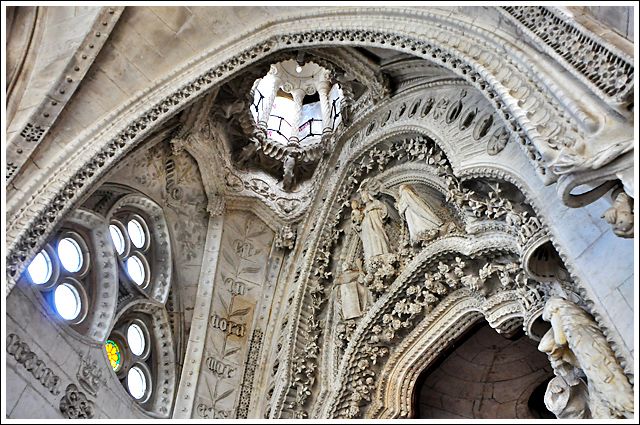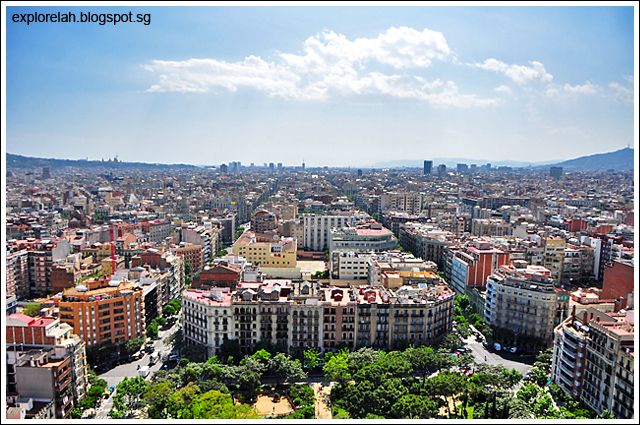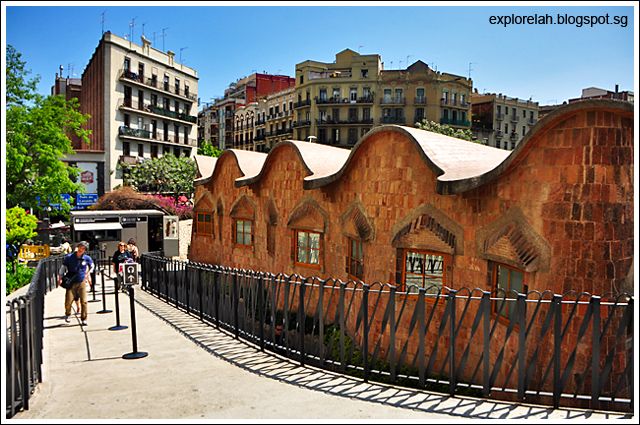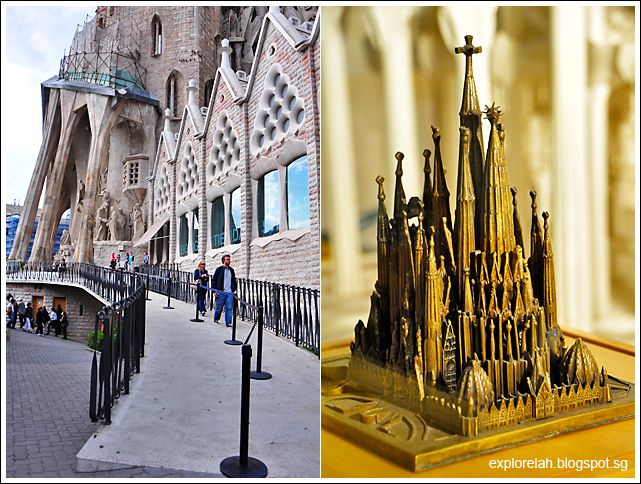Date of Exploration : 3 May 2011
"It looks like a pretty cake melting under the sun," mum remarked about Sagrada Familia. I didn't know to laugh or cry since we've been walking for about an hour to get to this top attraction in Barcelona, and some say all of Spain. Putting our soles through so much effort to see a piece of disintegrating confection hardly seemed worth it.
Will my mother's opinion change after our visit?
As the world-renowned church grew in size with each eager step towards it, I felt my own photographic sweet tooth growing too. By the time I reached its gated entrance, my camera was ready to eat up every square inch of this delicious looking house of God. And it did.
From the inside to the outside, from the basement museum to the tower top... from day, till night. My aperture savoured every brick, beam and mortar and got all heady with this crown jewel of Gaudi's architectural masterpieces.
Such a sugar high!
The Basilica i Temple Expiatori de la Sagrada Familia, simply known as
Sagrada Familia (English :
Church of the Holy Family) was designed by Catalan architect
Antoni Gaudi (1852 - 1926).
Building started in
1882 and to this day, some 130 years later, construction is still ongoing! The church's completion is slated to be in the year
2026 (to commemorate Gaudi's 100th death anniversary).
But despite its work-in-progress status, Sagrada Familia was named a
UNESCO World Heritage Site in 1984 and later proclaimed a
Minor Basilica by Pope Benedict XVI (who recently resigned from his papacy, the first Pope to do so in 600 years) in 2010.
Being decreed a Minor Basilica meant that Sagrada Familia is recognised by the Vatican to be an ancient and major religious center with significant devotional contribution to Catholicism. As for benefit, minor basilicas get precedence over regular cathedrals and churches. In travel terms, it's like being upgraded to Business Class from Economy. Currently, there are 1,609 minor basilicas around the world and 4 major basilicas (all seated in Rome). The Minor Basilica pool may seem crowded but few have the easy distinction that Sagrada Familia owns.
 |
| Josep Maria Bocabella, a Catalan bookseller, was inspired to build Sagrada Familia after a visit to the Vatican in 1872. Raising funds through donations, Josep engaged Francisco de Paula del Villar, President of the Association of Architects and Director of the Higher School of Architecture, to design and build Sagrada Familia in 1882. A year later, Villar left the project and Gaudi took over. |
Encountering this monolithic church for the first time, my eyes didn't know where to look. From afar, the 4 corncob spires grabbed my attention. But as we got closer, a pageant of decorations fought for attention.
However, when Sagrada Familia was first conceptualised by
Francisco de Paula del Villar, the church wasn't suppose to look like what it is today.
The first blueprints drawn by Villar were grounded in firm Neo-Gothic traditions but when Gaudi took over in 1883 after the former resigned from the project due to disagreements with stakeholders, Gaudi injected his brand of whims and penchant for organically geometric forms. The result is the wildly imaginative Sagrada Familia now, a one-of-its-kind Gothic church on earth.
Considering how cautiously Catholic pastoral bodies guard their prescribed standards, Gaudi must be a damn good salesman to convince the religious honchos and investors to buy into his unconventional vision for a church; a church that now overshadows Barcelona's official city-ordained place of worship, the Cathedral of the Holy Cross and Saint Eulalia (commonly referred to as Barcelona Cathedral).
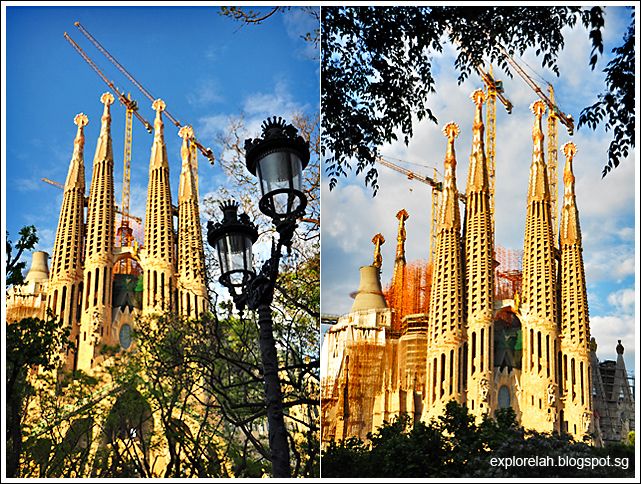 |
| Upon seeing the church, it's very tempting to go right up front and start snapping photos. But cross over to the park opposite Sagrada Familia's main entrance and you'll find some interesting foreground objects (such as the lamppost) and foliage to frame a shot. |
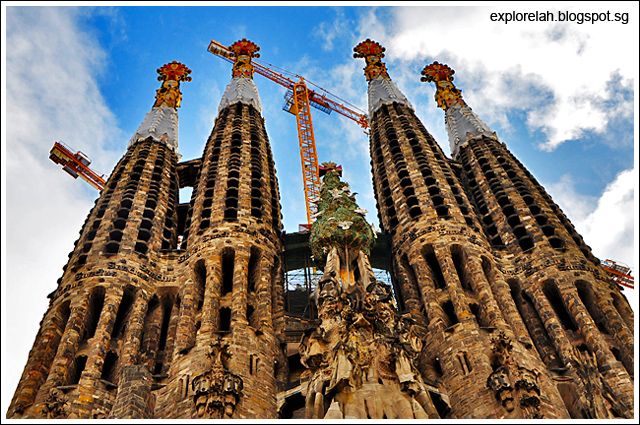 |
| My first association of the 4 organic-looking spires was with termite hills. Insect condo. But after a few shots, I think corncobs were more appropriate. |
Stepping into Sagrada Familia
It is easy to feel overpowered by Sagrada Familia's aesthetic idiosyncrasies. I felt like Alice
(or should it be Maurice?) in Wonderland stumbling upon one surprise after another, where a smorgasbord of visual elements culminate in a chaos that made me want to run away, yet held me willingly captive.
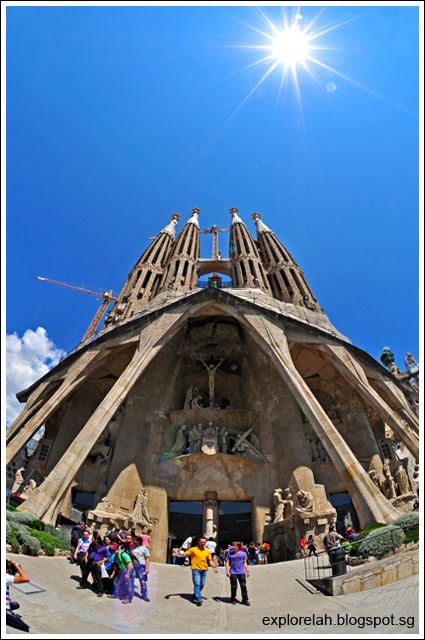 |
| The Star of David? Nah... it's just the scene shot at F16, 1/200 secs, ISO 200. |
Why is Sagrada Familia so captivating? For one, it's the unusual combination of masonry that marries the contemporary with a reinterpretation of antiquity. Secondly, there are the may sculptures to study, stained glass light pockets to bask in, and achitectural curiosities and symbols to decipher.
Then there's the exploration of the spires to rise up to and an underground museum to burrow deep into the history of Sagrada Familia.
 |
| The Passion facade (West entrance) depicts the story of Jesus' sufferings. |
To truly appreciate and make sense of all the sculptures, statues and carvings on Sagrada Familia is to treat the entire building like a 3D pop-up book that tells the Biblical story of Jesus... from His immaculate conception to His sufferings and finally, His ressurection.
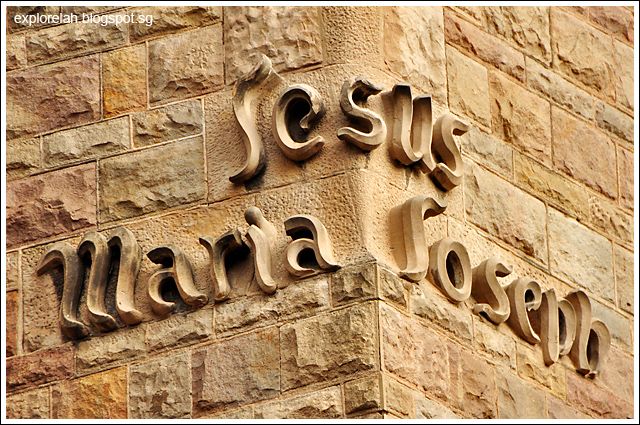 |
| The Holy Family consists of child Jesus, the blessed virgin Mother Mary, and Saint Joseph, Jesus' earthly foster father. |
These 3 stages of Jesus' life and times are retold through the 3 grand facades of Sagrada Familia - Nativity (East), Passion (West), and Glory (South). Entrance to the church is via the Passion facade which traces the tribulations Jesus went through.
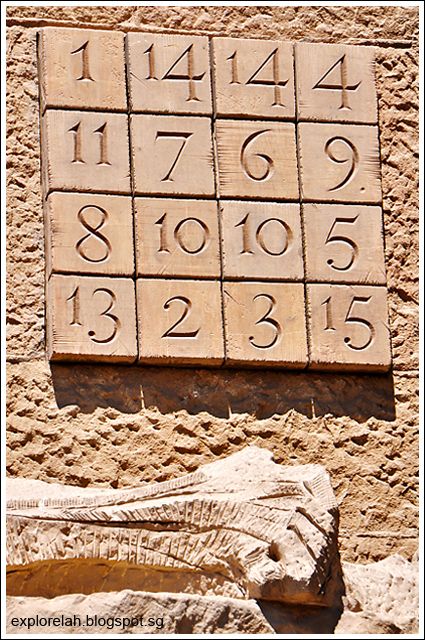 |
| The Passion facade has a magic square that adds up to 33 across all horizontal, vertical and diagonal rows as well as within each 4 squares. So amazing! But why the total of 33? Well, that's the age Jesus was crucified and rose again. |
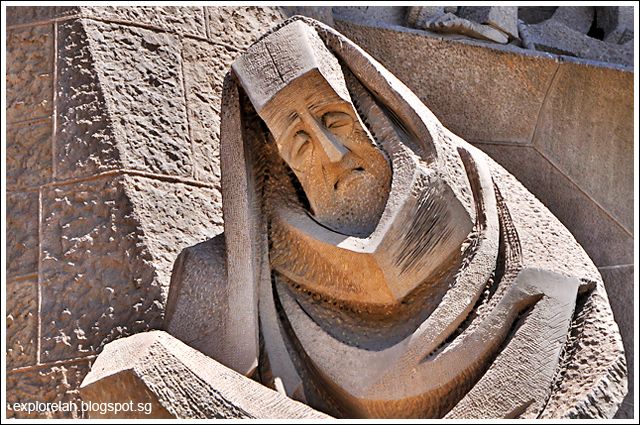 |
| Stylistic techniques that depart from the realism sought by Romanistic sculptures added a contemporary edge to the century-old Sagrada Familia. |
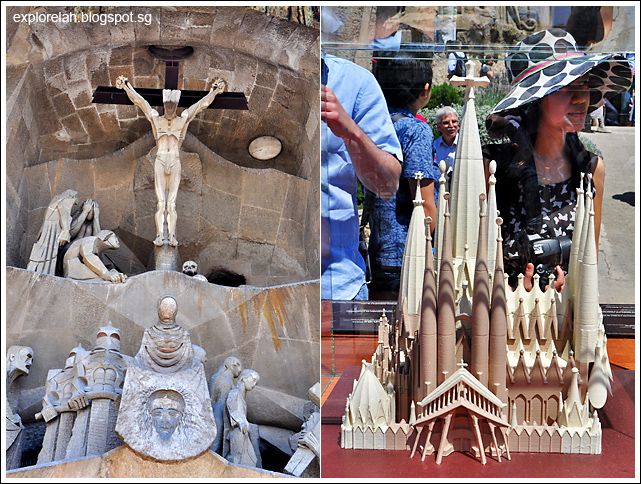 |
| Sagrada Familia has 18 towers representing the 12 apostles, 4 evangelists, Mary and Jesus Christ. Jesus' tower is the tallest at 170m and crowned by a large cross. When completed, Sagrada Familia will be the tallest church in the world. |
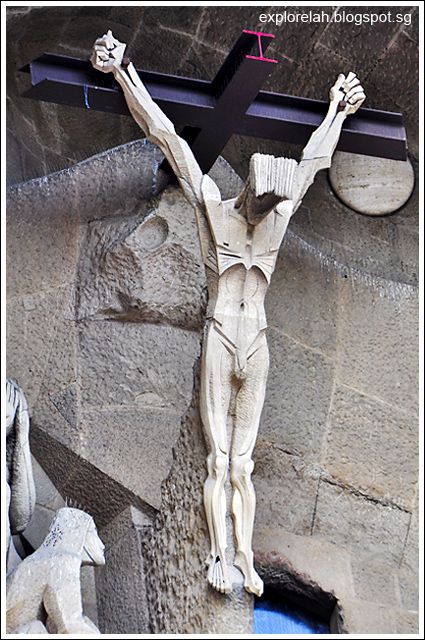 |
| My eyes widened slightly at the missing loin cloth that traditionally covered Jesus' *ahem* family jewel. |
 |
| Behind the sculpture of Jesus chained for torture are the Alpha and Omega symbols given an angular twist. |
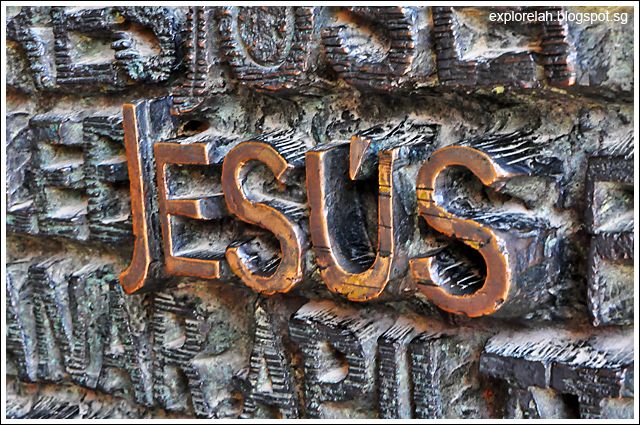 |
| "I am the light of the world: he that followeth me shall not walk in darkness,
but shall have the light of life." - John 8:12 |
Ceiling of a Thousand Blooms
As soon as we entered Sagrada Familia, I lost sight of mum and stepdad for I was so engrossed in shooting the visages. The next time I saw mum, I was standing at the entrance to the church's interior. She was quite some steps ahead of me and had her head cranked up, mouth slightly opened.
I think I saw a light trail of drool down the side of her mouth.
I followed her gaze... What happened next was that I had to recover my jaw from the floor.
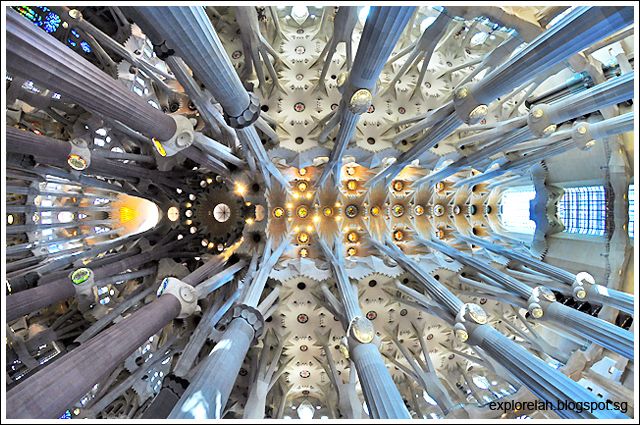 |
| Took this shot with a fisheye lens and setting my camera on timer mode and placing it on the floor. To get the central spot of the church to shoot, I used the ceiling discs and floor patterns as guides. You have to be a little patient as with an angle so wide, it's easy for people to walk into the shot and you may have to try a few times. Also, don't mind the weird stares you'll get! |
Oh. My. God. The ceiling is so supremely breathtaking! Inspired by nature, Gaudi had fashioned the church's interior after tree trunks, foliage and flowers. I call it the
White Garden of Eden.
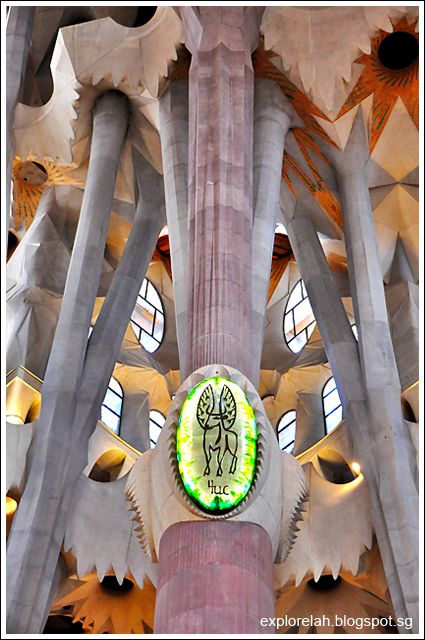 |
| At the knee of the supporting beams are zodiac shields that glow like gems. |
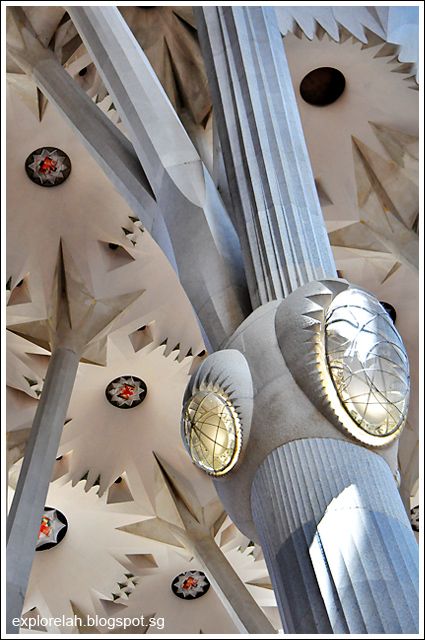 |
| Let's get this straight. There is hardly any straight line in sight with Gaudi's dance of the paraboloids swirled with conoids and topped with hyperboloids! What all these 'oids' mean is the mathematical distortion of straight lines to form curves, cones, hour-glass figures, etc. |
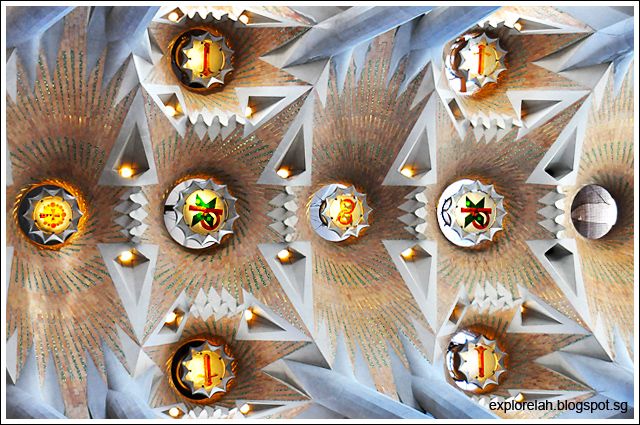 |
| They resemble bottle caps but when I stared long enough at the ornate ceiling, I get a somewhat trippy, transcendental feeling. Try it when you're here! |
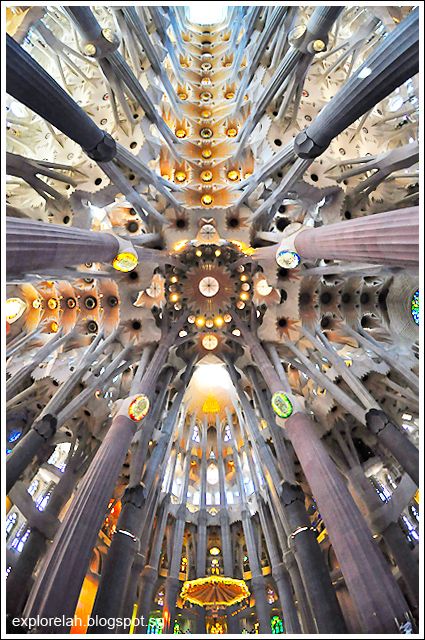 |
| More of the divine organic ceiling. Heaven is a place on earth! |
 |
| This was taken near the pulpit and altar in the apse. The area was cordoned off but I set my camera on timer mode, reached under the barrier and placed it on the floor for this shot. |
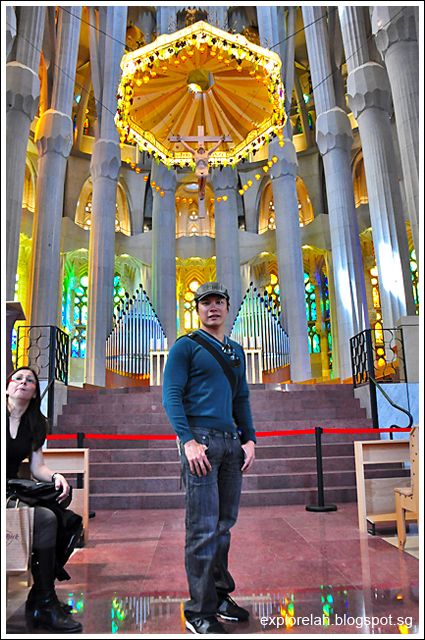 |
| See the queue poles behind me? I placed my camera on the floor past the barrier for the shot above. But of course, this is the quinessential "I was here" shot. Heh heh. |
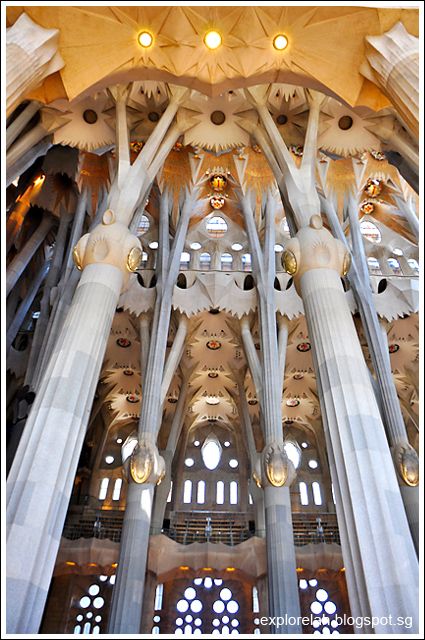 |
| It feels more like a limestone cave filled with stalagmites and mineral columns / draperies than sacred basilica in here. Simply magical! |
 |
| As the sun shifts its position through the windows and stained glass, colourful floral patterns slowly glide across the floor like a moving carpet. |
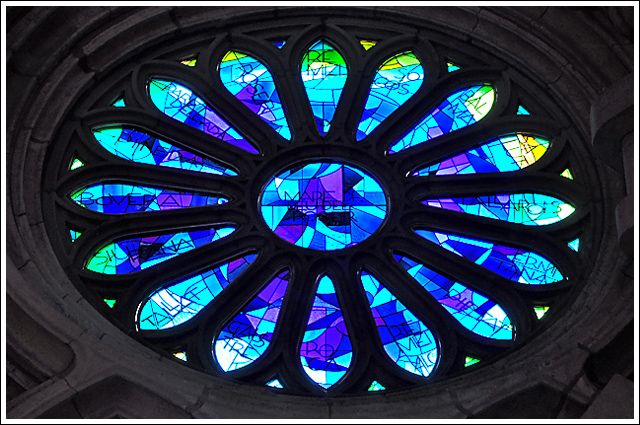 |
| Glass flower. |
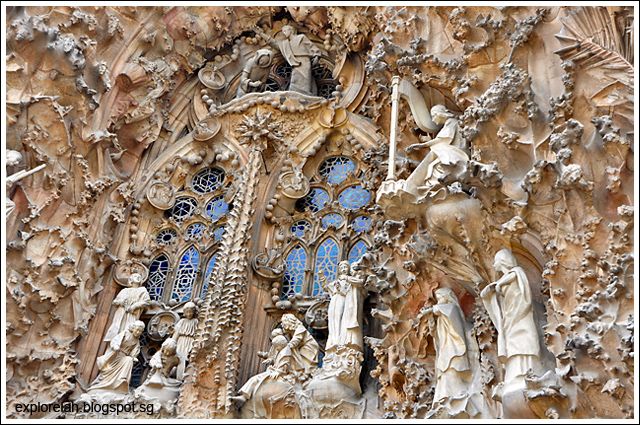 |
| After exploring the interior, I took the East exit and found myself looking at the busily decorated Nativity facade. |
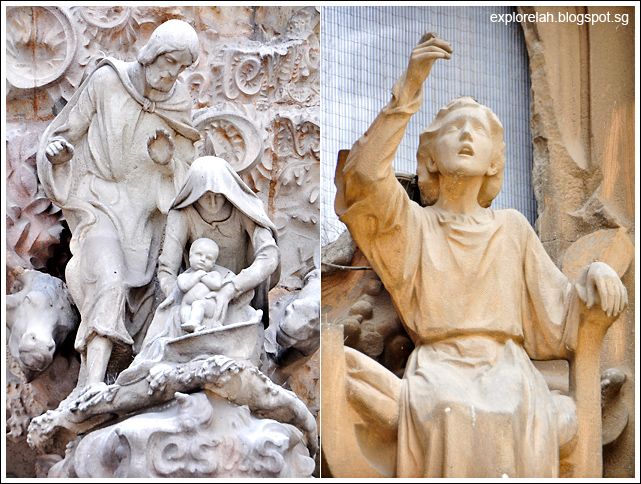 |
| The Nativity visage depicts the conception and birth of Jesus and represents hope, charity and faith. |
 |
| Among the mess are scenes of harmony and peace with a profusion of plants and animals. It is a symbolic celebration of God as the creator of all life. |
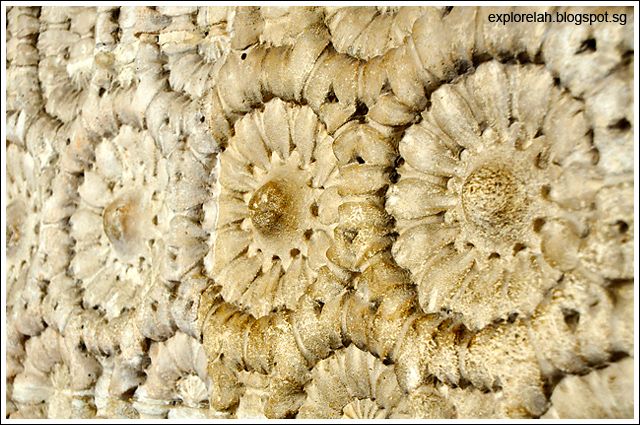 |
| Intricately carved flowers laced pillars and walls with impressive effect. Being a wallflower isn't so lame after all! |
Up Inside the Corncob Towers
One of the must-do at Sagrada Familia beside gawking at the architecture is going up one of the towers for a bird's eye view of Barcelona. There's an extra charge for ascending the towers but it's worth it the price and the vertigo.
 |
| A study of art and form as I headed to towards the lift to go up one of the towers. |
 |
| At the point of ticket purchase, you can select the time to take the lift. I selected the 3.40pm slot and queued for about 30 minutes before my turn came. There's only 1 lift going up and down. |
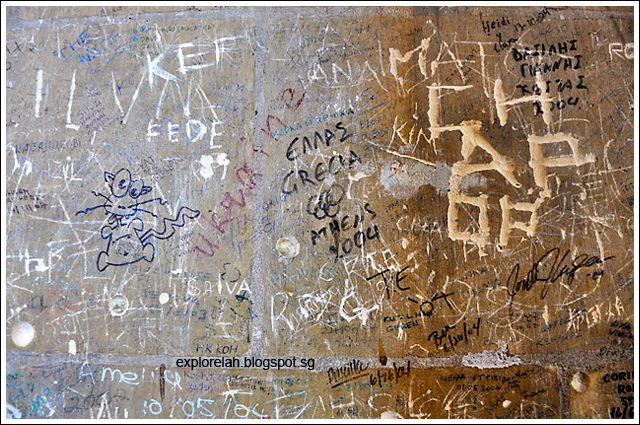 |
| Visitors leaving their mark on the inner walls. I left mine too, digitally, so as not to deface the church. |
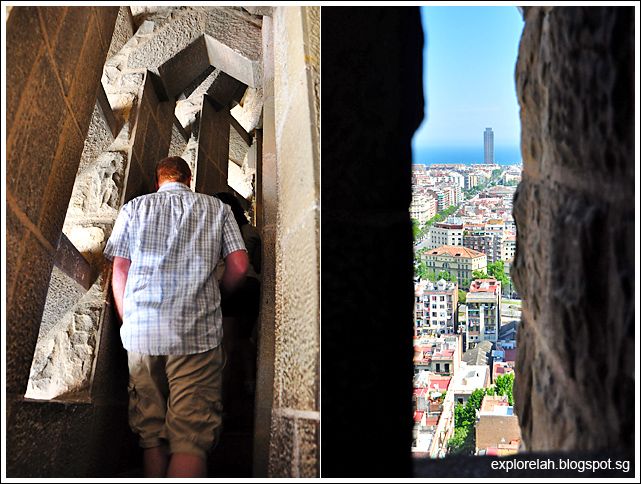 |
| Tight spaces and narrow walkways. The lift dropped us off mid tower and we had to climb some steps, in single file, to go higher. It can feel a little claustrophobic but there are certain points with recessed nodes to take a step back and let the people behind pass. At one point, I was walking behind this heavyset lady who seemed to bounce off the walls with each step. |
 |
| Slits along the passageway offered glimpses of the view outside in a spiral game of peek-a-boo. |
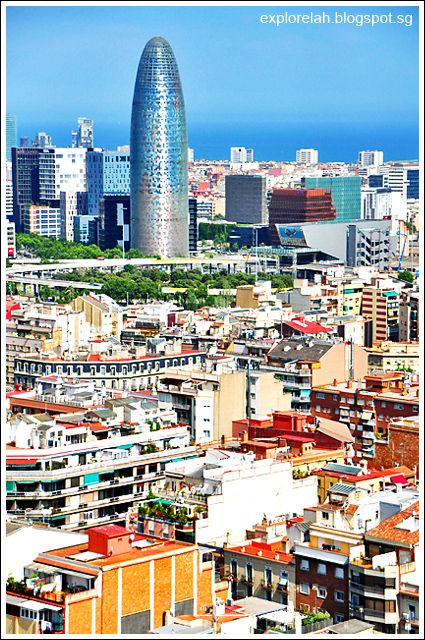 |
| The colourful cityscape of Barcelona. |
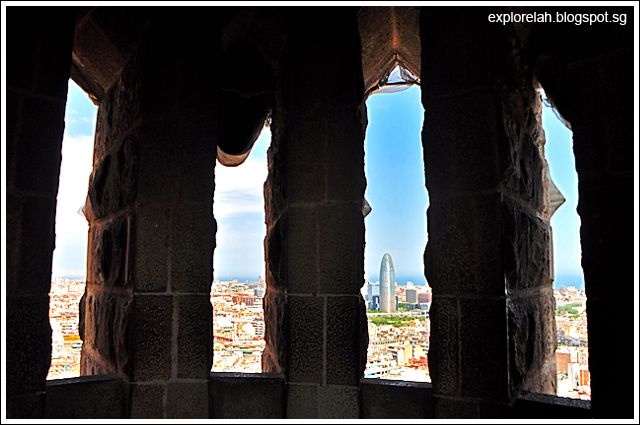 |
| After a relatively short climb, we reached the top of the tower. Walking speed is dependent on who's in front of you in such a confined space. Slow-moving visitors and those who stop at every point to take photos will cause a staccatoed trail. |
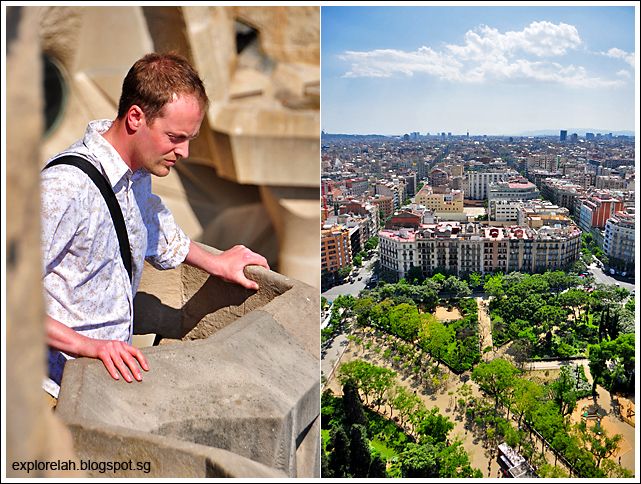 |
| Occasional pockets of balconies test one's appetite for extreme elevation. This guy looked like he's holding on for dear life! |
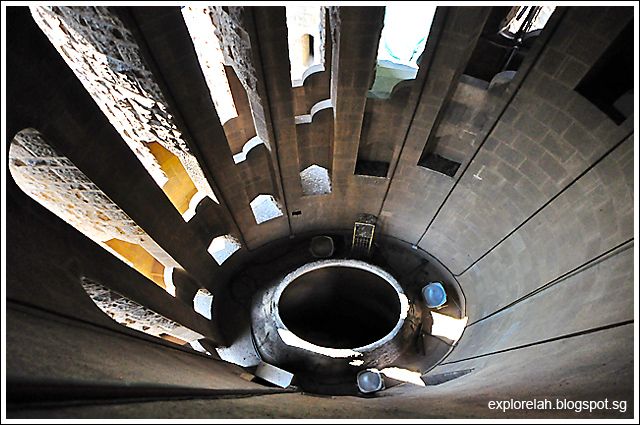 |
| Turning my focus inward, I came face-to-face with a hollow well within the tower that kinda drew me in like a magnetic vortex. |
 |
| Sunlight bursting through a hoarded window. This was one of those occasions where I'm thankful for my small built. I let the tourists behind me pass through before taking my time to adjust my cam settings and frame this shot. |
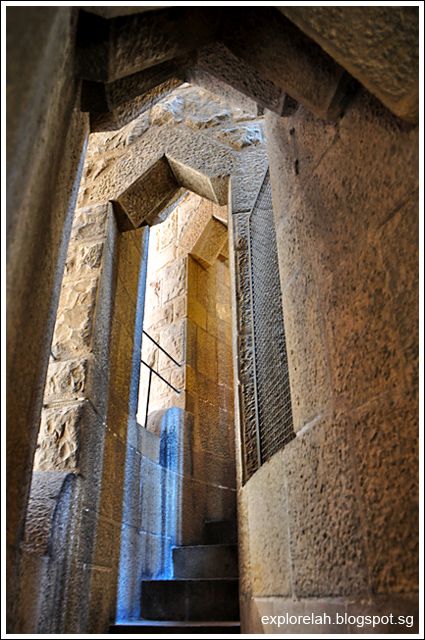 |
| While the towers receive a lot of visitors, it is possible to wait for each batch the lift brought up to clear in-between for clean shots of the tower's interior. |
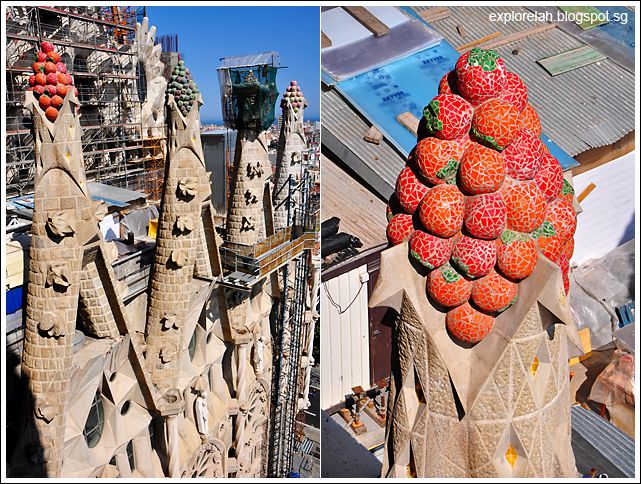 |
| Now I know why my mum said Sagrada Familia is like a cake. A strawberry shortcake perhaps? |
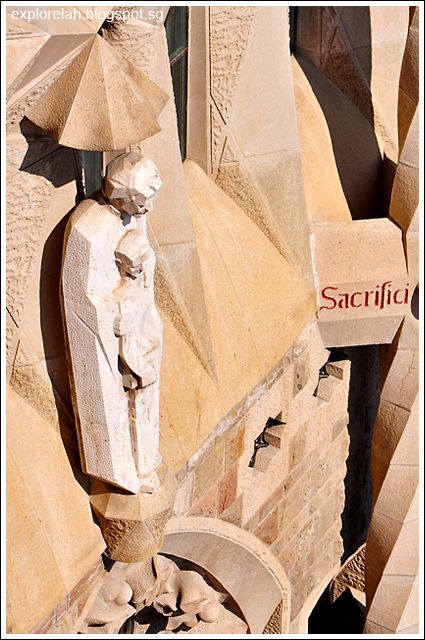 |
| Sprawled across beams and crannies of the church's roof are statues and texts calling out to the faithful to observe and reflect. |
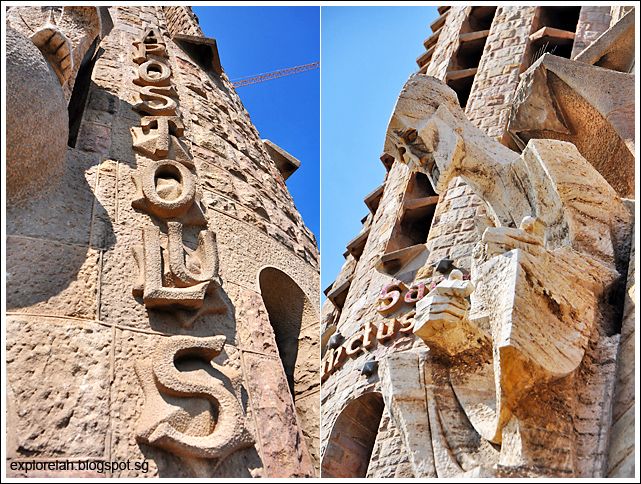 |
| Some of the words read like a Harry Porter spell and the statues look rather creepy though. |
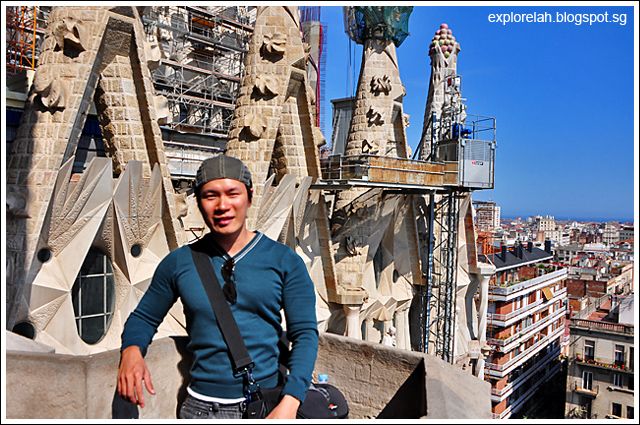 |
| A "I was up here" shot. Thank goodness the stranger taking this photo didn't go any lower to show my piss stain. I don't fancy heights! |
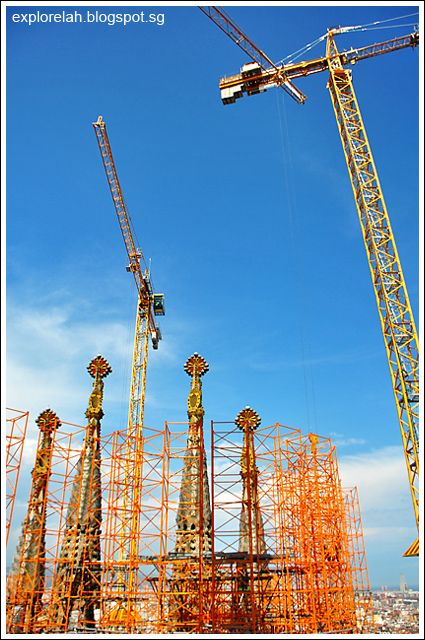 |
| Reaching to heaven were the cranes. |
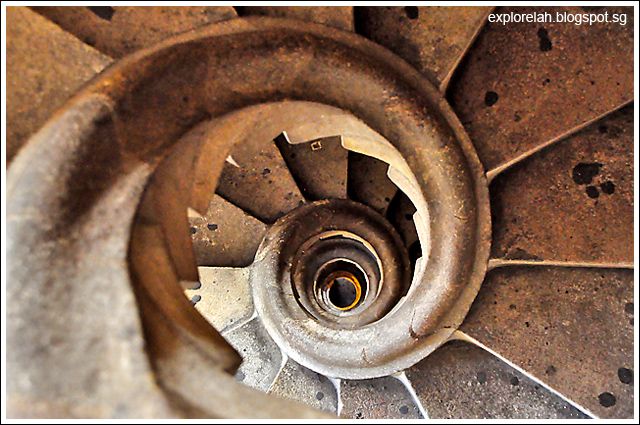 |
| Leaving the crammed tower trail that liberated the metropolitan landscape of Barcelona, I was presented with 2 options to get back down - take the lift, or walk the dangerous-looking flight of stairs that wind like a dragon's tail to the navel of hell. |
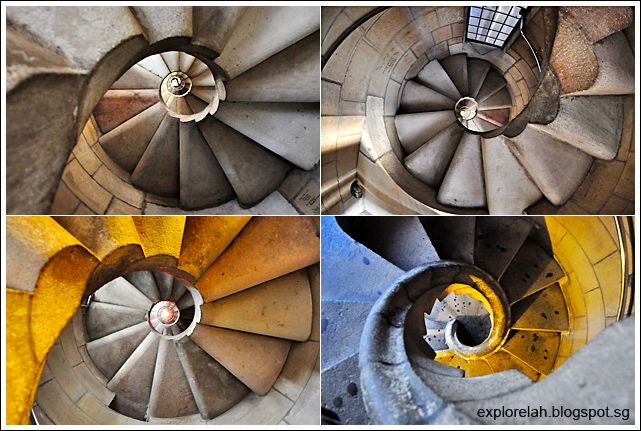 |
| I chose the more scenic and longer way down. The spiral stair well makes for some really interesting shots that call to mind the architecture of a snail or nautilus shell. |
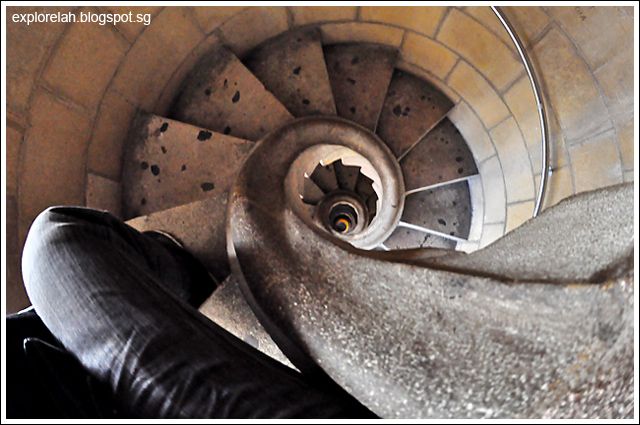 |
| I have skinny legs and a Hobbit's ass but look how I'd fill up the whole width of the steps. Talk about life on the edge with such a thrilling way to go down. |
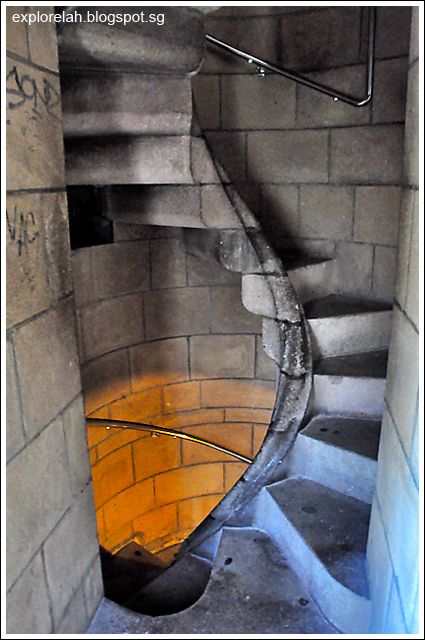 |
| Notice that there are no hand railings along the inside spine and how low it is at the same level as the steps. Making my way down felt like a minor Cirque du Soleil act! |
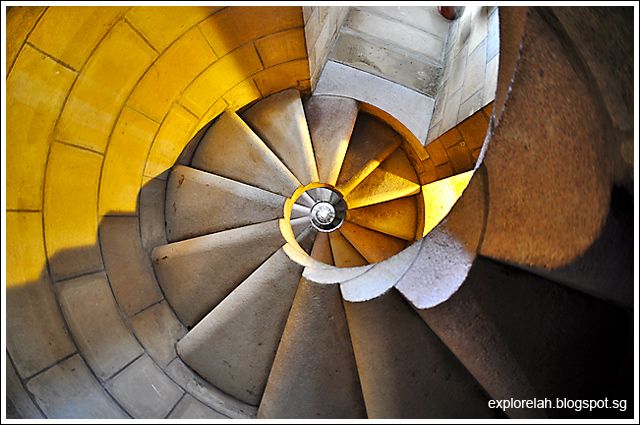 |
On the bottom shooting up. The end of the stairway reeked of stale urine. I don't know if they were smell signatures left by visitors in place of written ones but don't attempt any inhale Hail Marys here! |
Sagrada Familia Museum
Languishing from the heavy photographic documentation of Sagrada Familia's architectural marvels, I was pretty much spent after the tower tour. But there's one more place to check out... the museum at the church's basement.
The existence of the museum caught me by surprise since results from my online research presented only showcases of the church's exterior and interior but nothing of its underground history vault.
Just as the construction of Sagrada Familia is ever onging, this blog post will also be a piece that gradually builds up with more photos and information being added over the course of perhaps a few days, or a few weeks, till it is completed.
A lot more stories, pictures, visitation anecdotes and photography tips will be added daily so do check back for updates! Hope you'll follow this entry to the end. I promise this will be a very comprehensive guide to visiting this magnificent church :o)
Last updated : 28 Mar 13 (Singapore time : 1:10 am)





































